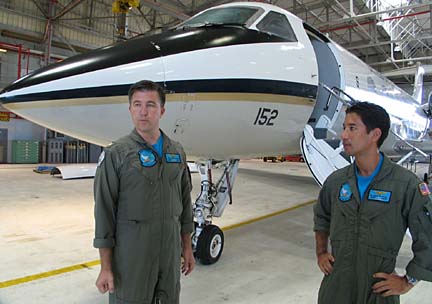
GREGG K. KAKESAKO / GKAKESAKO@STARBULLETIN.COM
Navy Reserve pilots Lt. Cmdr Steve Whitmore, left, and Lt. Cmdr. Blandon Picl are midway through a two-year active duty tour flying support missions for the U.S. Central Command from Qatar.
Dedication to service drives
post-9/11 Naval Reserve force
The Naval Reserve faces a major personnel realignment driven by a need to make it more responsive to the needs of the country and the Navy.
During the Cold War, says Rear Adm. David Anderson, a Reserve jet pilot who was chosen to spearhead this project, "the Navy Reserve's prime mission was to mobilize to fight World War II."
However, since the fall of the Berlin Wall and the current war on terrorism, "we know that we are not going to mobilize the entire force at one time," Anderson said in a phone interview from U.S. Fleet Forces Command in Norfolk, Va., last week.
"It will no longer be a large foot print, but a smaller surgical strike force."
Anderson said the situation at one time was so bad that "there were reservists assigned to ships that had been decommissioned."
But the Sept. 11, 2001, terrorist attacks served as a wake-up call when more than 22,000 reservists were mobilized.
Anderson, 49, said there are another 20,000 Naval reservists like himself who weren't mobilized for a year or longer, but placed on active duty for shorter periods of time when their skills were needed. Although Anderson wasn't mobilized for a year, he estimates that he still has to take off about 25 days a month from his job as a pilot for Federal Express because of his Naval Reserve commitments.
He said there are now more than 87,000 Naval reservists who make up 20 percent of the Navy's total force, and the Navy is trying to find a way to better use their services and integrate them into the active force.
Anderson acknowledged, however, that many of the 1,484 Naval reservists assigned to Hawaii may not feel the change because of the heavy concentration of Navy ships and activities.
"They already work hand-in-hand with the active duty folks there," Anderson said.
One such unit would be the 62-member Fleet Logistics Support Squadron 51 at Kaneohe Marine Corps Base, where more than half of its roster are reservists. Lt. Cmdr. Steve Whitmore, who in civilian life is a pilot for United Airlines, said VR-51 couldn't exist without the reservists.
"We need the reservists," said Whitmore, who pilots one of two C-20 passenger and jet cargo planes maintained by the squadron. "I have been here since 1995, and we've always been closely integrated."
Navy Capt. Chester Wong, who has served for nearly three years as deputy director for intelligence at Camp Smith, said that 12 to 14 years ago the Navy was not integrated as it is now.
Wong, who in civilian life is a nuclear engineer at Pearl Harbor Naval Shipyard, spent 6 1/2 years on active duty as nuclear submarine officer. He has been in the Naval Reserve for 18 years in the intelligence field.
"There is a commitment now," said Wong, 46, "by the active force to rely on the work we do ... But it took 10 to 12 years before the active forces realized our capabilities and then provided us with more challenging projects."
The 29 Naval Reserve units here have skills that range from intelligence to construction and special warfare. The Navy says there are 482 officers and 1,002 enlisted sailors in these units.
The Naval Reserve accounts for 2,654 of the 172,650 reservists and National Guard personnel on active duty, the Pentagon said. In Hawaii, there are now 18 Navy reservists who have been mobilized.
Carney, who will return to his civilian job as a regional manager for nonprofit housing corporation at the end of the month after 2 1/2 years on active duty, said being a reservist takes sacrifices.
"You have to make sacrifices not only in your civilian job," Carney said, "but with your family as well. But I enjoy it. The things that we do I believe are important."
Since the 1991 Gulf War being in the Naval Reserve is no longer only one weekend a month.
Wong estimates that on the average for the past 2 1/2 years he has been placed on active duty for 60 days.
Whitmore, one of 33 reservists in VR-51, said that since February 2003 numerous members of his unit have been mobilized so it can keep at least eight people deployed to Qatar on the west coast of the Persian Gulf to support the efforts of the U.S. Central Command.
